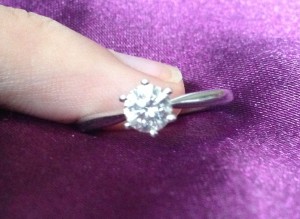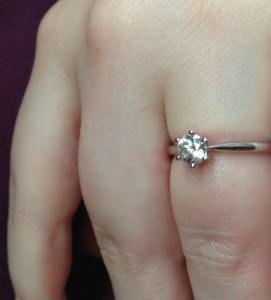 Buying the perfect diamond engagement ring is not easy. There are serious hurdles to navigate and hopefully this article will help you with some of them. You’re about to spend a serious amount of money you need to keep her happy, remember she’s going to be wearing this thing for the rest of her life but you also don’t want to get ripped off!
Buying the perfect diamond engagement ring is not easy. There are serious hurdles to navigate and hopefully this article will help you with some of them. You’re about to spend a serious amount of money you need to keep her happy, remember she’s going to be wearing this thing for the rest of her life but you also don’t want to get ripped off!
How much should you spend?
The first thing to remember with this is that everyone will try and bully you into spending as much money as possible. No matter how much your actually planning to spend you will be made to feel like its not enough. Walk into a jewelers planning to spend £5000 and they will gently make you feel as though your budget is inadequate and encourage you to spend more. Magazines will insist that you spend a minimum of three months salary. The industry is very cleverly set up to make you spend as much as possible. Don’t feel pressured. Set a budget on what your happy to spend and stick with it. Remember you’ve got a wedding to pay for! If she loves you she will love the ring no matter what. If she’s the sort of women who checks the size of the ring before saying yes or no shes not worth marrying in the first place. That all being said know one likes a cheap skate so a £10 ring from Tesco is not going to cut it so keep reading.
Online or Not Online?
I love to make savings buying stuff online but diamond engagement rings are a definite exception. Every stone looks different and you must see it in person before you buy it, no picture will ever tell the story so forget about buying online. It also will sound very unromantic when your fiancee asks where you bought the ring and your forced to tell her it’s from online.
If your worried about making a mistake you can buy a plain band for when you propose and then buy the ring with her so you can be sure you get one she likes. There are advantages and disadvantages to this. The advantage is you can be sure she gets what she wants.
The disadvantage is that your going to have to fork out if she falls in love with a ring. It also makes it much harder to negotiate when the jeweler knows you really want something. Proposing with a plain ring is also not as special and may detract from the moment.
Research
Doing your research is vital of you don’t want to make a mistake. It will mean you get the right ring and it could save you a fortune. The more you know the easier its going to be to negotiate and the more a jeweler will respect you.
Understanding the Four Cs
The look and value of a diamond is determined by four factors. Cut, Clarity, Carat and Colour
Cut
The cut is the only characteristic not determined by nature. A poorly cut diamond may have a compromised sparkle. The most common type of cut is the ’round cut’. In my opinion the traditional round cut or variations of it are by far the best cut because they sparkle the most, a lot more for example than the princess cut. However you should see all the cuts before making a decision. Types of cut include the the emerald, the pear, the marquise, the princess, the oval and the heart shape.
Clarity
The clarity is how perfectly the diamond has been formed in nature. Yes very few diamonds are perfectly flawless most will have little flaws which you can see under a magnifying glass. These flaws are called inclusions. Inclusions have a big impact on the value of a diamond
The grading of clarity according to the GIA (Gemmological Institute of America)
IF – Internally Flawless
VVS1 and VVS2 Very very slightly included inculsions which are very difficult to see even under 10x magnification
VS1 and VS2 – Very Slighty Included – Difficult to see under 10x magnification
SI1 and SI2 – Slightly Included – Easy for a trained grader to see under 10x magnification
I1, I2 – Included obvious inclusions usually visible to the naked eye
I3 – Large inclusions that typically impact the fire of the diamond and potentially threaten the structure of the stone
Inclusions are a big part of why you need to see a diamond in person. Inclusions can affect the sparkle or fire of a diamond. Sometimes a diamond which has a higher grade may actually have a bigger impact on sparkle than a lower grade. People can make to bigger deal about inclusions. Remember a diamonds inclusion make it unique. Personally I think the money you would spend to buy a VS diamond would be better spent on carat or colour. You should however try to avoid severe inclusions which might compromise a stones sparkle or structure. Again this a personal choice and you must find for yourself what you want but I think the SI categories often offers the best value. Remember though that two diamonds from the same category might look completely different. You must judge how the stone looks.
The most valuable and rare diamonds are colourless and are graded D. The colour scale runs from D to Z. Diamonds with a very distinct colour are rare and are called fancies. Diamonds typically get more yellowish as you move down the scale. Colour is important but again it is not something I would obsess over as long as you get a reasonable grade. You or your fiancee are not going to tell the difference between an F and an H. In my opinion I would suggest you can probably go up to a J without really having much idea that your diamond was slightly yellow. For me an I or H rating represent the best value but again these are all personal opinions you might find that for you only a D or E grade will do. Remember every stone is different trust your eyes don’t just focus on the grades.
Carat
The Carat or the weight and therefore size of the diamond. Not to be confused with karats the purity measure for gold. The carat has a big effect on value and is the first thing everyone will notice. As the size of the carat increases the price grows exponentially. Most diamonds for engagement rings fall between 0.25-2 carats. You will want to get as bigger carat as you can within your budget without compromising too much on the other Cs. Don’t believe everything your told by jewelers when it comes to carat. For example they may say to you on that budget you won’t be able to buy a carat bigger than X. I was initially shown much smaller diamonds than the one I was eventually able to buy.
Certified or Uncertified
A certified stone is – a diamond that has been assessed, graded and coded with a laser by an independent gemological laboratory. The most well known and recognised is GIA. Other popular certificates include HRD, IGL, EGL and AGS. The disadvantage of an uncertified stone is that you are trusting the jeweler. However a cert stone is usually a few hundred pounds more expensive. A cert stone will also ensure you have not been sold a fake. If you are buying a very expensive stone having a cert stone is probably worth it. If you have a smaller budget you may prefer to risk going without a cert stone. The decision must be yours. Diamonds can be artificially treated or fracture filled and sold legally although you must be told. Avoid these and avoid anything which is ‘clarity enhanced’.
Looking Out for Fakes
The ring itself
The most common rings today seem to be from white gold and platinum which both look quite similar. You can also go for a yellow gold or a white and yellow gold mix although personally i prefer the platinum or white gold look. Platinum is slightly more expensive than 18 karat white gold. Try and go for at at least 18 karats if you can, no one wants 9 karat gold for an engagement ring. Remember 9 karat gold is just 37.5% pure compared to 75% for 18 karat. If they can keep a secret try and glean information from your fiances family and friends as to what her taste is. You can differentiate your ring by choosing a variety of different settings although the diamond solitaire seen in the pictures above is the most common. If you can try and find out what size ring she takes from her friends or family. If you can’t, don’t worry too much any reputable jeweler will allow you to get it refitted although this may cost extra.
Buying the Diamond Ring
Where to Buy?
First of all set aside at least half a day don’t buy a ring in a rush. Do not buy from a high street jeweler you will almost certainly get ripped off and you will have limited choice. If you can try and go to an area where there are a lot of jewelers in one place. Hatton Gardens in London is the best place to go to. There are at least 30 jewelers next to each other. You can be assured of competition and a wide choice. Most of the jewelers also have good reputations.
Don’t Get Sucked In
First go around every store and check the windows to get an idea. People will probably come out and try and get you to come inside. Talk to them to get more information if you want but don’t go inside yet. Try and work out which shops are offering the best deals. Bear in mind that jewelers will display their best and usually most expensive wares. They will usually have more inside the store. Take pictures of any rings which catch your eye and move on.
When you’re ready choose a ring which you liked and go into the store and ask to have a look at it. Here’s where you can make use of all that research you’ve done. Ask the jeweler about the cut carat etc. Ask to see the ring under 10x jewelers loupe and on a white background (a black background can hinder the eyes perception of a diamonds colour). Ask if the ring is certified and who did the grading. Remember that an uncertified ring is not necessarily a bad thing and will usually mean a cheaper ring but is something you need to be aware of. Ask the jeweler what guarantees and warranties they offer.
Then ask if the jeweler has any similar rings to compare it to. All this will make it clear to the jeweler that you know what your talking about and it will make it easier to negotiate later. Don’t be afraid to take your time. Choose the ring which you like the most and ask the jeweler for his best price on that ring. Thank the jeweler make a note of the details of the ring and tell him/her you’ll be back if you don’t find anything better. Also remember to ask the jeweler about re-sizing costs, the setting and the material of the actual ring.
Go into the next shop and repeat until you have a really good picture of whats available and you know what you want.
How to Negotiate
Negotiating can be uncomfortable but you absolutely must do it. Remember they are the ones profiting from you and you have the power to go elsewhere. A general rule is to get at least 15%-20% off the list price at a minimum. Don’t seem too keen if you really want a particular ring.
A good first move is to ask the jeweler what his or her best price is. That should be your starting point for negotiations. Use your budget as a negotiating tool. When you’ve clinched the deal remember to get a receipt and remember to ask about fittings.Try and get one for free if you can.
You may also want to read this excellent guide to buying engagement rings from the Guardian
Good Luck!


